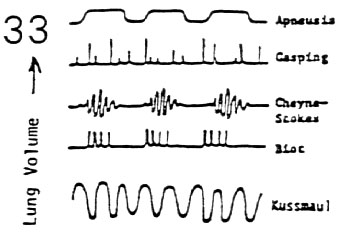Kussmaul breathing is a deep and labored breathing pattern often associated with severe metabolic acidosis, particularly diabetic ketoacidosis (DKA) but also renal failure. It is a form of hyperventilation, which is any breathing pattern that reduces carbon dioxide in the blood due to increased rate or depth of respiration.
Kussmaul breathing is respiratory compensation for a metabolic acidosis, most commonly occurring in diabetics in diabetic ketoacidosis. Blood gases on a patient with Kussmaul breathing will show a low partial pressure of CO2 in conjunction with low bicarbonate because of a forced increased respiration (blowing off the carbon dioxide). Base excess is severely negative. The patient feels an urge to breathe deeply, an "air hunger", and it appears almost involuntary.
A metabolic acidosis soon produces hyperventilation, but at first it will tend to be rapid and relatively shallow. Kussmaul breathing develops as the acidosis grows more severe. Indeed, Kussmaul originally identified this type of breathing as a sign of coma and imminent death in diabetic patients.
Duration of fasting, presence or absence of hepatomegaly and Kussmaul breathing provide clues to the differential diagnosis of hyperglycemia in the inborn errors of metabolism
Content courtesy: Wikipedia, Patterns of breathing: Loyola University Medical Education Network. Video from Youtube


No comments:
Post a Comment